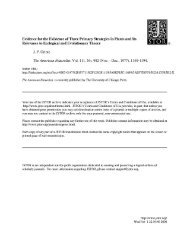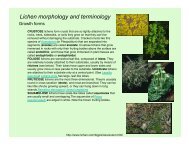Arctic Ecosystems in Russia - Alaska Geobotany Center
Arctic Ecosystems in Russia - Alaska Geobotany Center
Arctic Ecosystems in Russia - Alaska Geobotany Center
Create successful ePaper yourself
Turn your PDF publications into a flip-book with our unique Google optimized e-Paper software.
362 Yu.I. CHERNOV AND N.V. MATVEYEVA<br />
edition of the <strong>Arctic</strong> Flora of the USSR. Important<br />
contributions to the study of the flora of arctic<br />
Eurasia were made by the founder of that series,<br />
Tolmachev, and some of his successors from the<br />
school created by him (Yurtsev, 1966, 1974; Petrovskyi,<br />
1973, 1985; Rebristaya, 1977; Yurtsev et<br />
al., 1978; Tolmachev, 1986). At present, the composition<br />
of the vascular plant flora is one of the<br />
most advanced l<strong>in</strong>es of biological <strong>in</strong>vestigation at<br />
high latitudes.<br />
In general, the taxonomy and the zonal and<br />
regional distribution of mosses and lichens, the<br />
most important cenosis-formers <strong>in</strong> the <strong>Arctic</strong>, have<br />
also been clarified. A basic handbook of arctic<br />
mosses was published <strong>in</strong> 1961 (Abramova et al.,<br />
1961), and a number of recent papers are devoted<br />
to mosses and liverworts from different regions<br />
of the <strong>Russia</strong>n <strong>Arctic</strong> (Blagodatskikh, 1973;<br />
Zhukova, 1973, 1978, 1986; Afon<strong>in</strong>a, 1978; Blagodatskikh<br />
et al., 1979a,b; Kannukene and Matveyeva,<br />
1986; and others). Studies of the arctic lichenoflora<br />
have also greatly progressed due to the<br />
<strong>in</strong>vestigations carried out at the Taymyr and<br />
Yamal pen<strong>in</strong>sulas and Chukotka (Pi<strong>in</strong> and Trass,<br />
1971; Mart<strong>in</strong> and Pi<strong>in</strong>, 1978; Pi<strong>in</strong>, 1979a,b, 1984;<br />
M.P. Andreyev, 1983,1984a,b; and others).<br />
Soil algae, as well, play a very important role <strong>in</strong><br />
terrestrial communities of tundras and especially<br />
of polar deserts. Therefore, data on these organisms<br />
are necessary <strong>in</strong> connection with the biocenology<br />
of the tundra, particularly <strong>in</strong> studies on trophic<br />
relationships. Intensive studies of soil algae <strong>in</strong><br />
the Eurasian arctic landscapes were started as<br />
recently as the end of the 1950s (Dorogostaiskaya,<br />
1959; Novichkova-Ivanova, 1963; Dorogostaiskaya<br />
and Sdobnikova, 1973; Getsen, 1985;<br />
and others). In all these works, much attention was<br />
given not only to the composition of the algal<br />
flora, but also to problems of ecology.<br />
The development of studies of the mycoflora of<br />
Eurasian tundras was comparatively slow (L<strong>in</strong>d,<br />
1927, 1934; Lebedeva, 1928; Vasilkov, 1967, 1969;<br />
Stepanova and Tomil<strong>in</strong>, 1971, 1978; Tomil<strong>in</strong>,<br />
1971; Bab'eva and I. Chernov, 1982; I. Chernov,<br />
1985). So far, only the broad features of the<br />
taxonomic composition of this very important<br />
group of organisms have been established. Some<br />
dist<strong>in</strong>ctive peculiarities of fungal biology and life<br />
cycles <strong>in</strong> arctic conditions have been po<strong>in</strong>ted out.<br />
Yet, tundra mycology <strong>in</strong> <strong>Russia</strong> is still at its <strong>in</strong>itial<br />
stage of development, though <strong>in</strong>vestigations on<br />
tundra fungi may be of great general significance.<br />
In particular, analyses of the tundra yeast flora<br />
have proved the necessity of revis<strong>in</strong>g many traditional<br />
ideas on the taxonomy of unicellular fungi<br />
(I. Chernov and Bab'eva, 1988).<br />
Information on the soil microflora of the <strong>Russia</strong>n<br />
arctic landscapes is also at an <strong>in</strong>itial stage,<br />
with earlier work hav<strong>in</strong>g been limited to some<br />
episodic works by Isachenko and Simakova<br />
(1934), Kriss (1947, 1952), and Sushk<strong>in</strong>a (1960). At<br />
the end of the 1960s, Par<strong>in</strong>k<strong>in</strong>a started her <strong>in</strong>vestigations<br />
on Taymyr. Ow<strong>in</strong>g to her systematic work,<br />
studies on the composition of the microflora<br />
and on the bacterial ecology of tundra soils have<br />
made noticeable progress (Par<strong>in</strong>k<strong>in</strong>a, 1971, 1973,<br />
1979a-c, 1986). However, there have so far been<br />
no successful attempts to carry out a detailed<br />
analysis of procaryotic communities at a species<br />
level.<br />
For a long time tundras have attracted the<br />
attention of ornithologists. Numerous publications<br />
have been devoted to the avifauna of tundras and<br />
polar deserts of Eurasia, <strong>in</strong>clud<strong>in</strong>g vast summaries<br />
of both a general character (Pleske, 1928; Danilov,<br />
1966; Uspenskyi, 1969) and a regional one (Krechmar,<br />
1966; Portenko, 1972, 1973; Krechmar et al.,<br />
1978; Danilov et al., 1984). Many publications<br />
have been devoted to separate groups of birds, to<br />
the regularities of their distribution, and to the<br />
history of avifauna formation (Tugar<strong>in</strong>ov, 1929;<br />
Kishch<strong>in</strong>skyi, 1974). A number of works have been<br />
devoted to <strong>in</strong>dividual species, especially to those of<br />
economic importance or <strong>in</strong> need of protection.<br />
Many important ecological problems have been<br />
elucidated us<strong>in</strong>g bird examples. The birds are one<br />
of the ma<strong>in</strong> groups used <strong>in</strong> study<strong>in</strong>g adaptive<br />
processes, communication and ecology, and biocenotic<br />
relations <strong>in</strong> the conditions of the <strong>Arctic</strong>.<br />
Many basic summaries, both general (Shwarts,<br />
1963) and regional (Yud<strong>in</strong> et al., 1976; Chernyavskyi,<br />
1985), have been devoted to the mammals<br />
of Eurasian tundras. The fur-bear<strong>in</strong>g tundra animals<br />
have been constant objects of various ecological<br />
<strong>in</strong>vestigations - <strong>in</strong>to their autecology, ecophysiology,<br />
population ecology, and biocenology. In<br />
particular, lemm<strong>in</strong>gs are the classical object for<br />
studies on population cycles - a question of great<br />
general ecological significance (Chernyavskyi and<br />
Tkachev, 1982). A series of studies on fundamental<br />
regularities of adaptive processes under extreme<br />
conditions have been based on arctic mammals<br />
(Shwarts, 1963).<br />
S<strong>in</strong>ce the middle of the last century, constant




